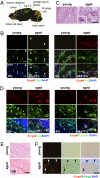Esophageal cancer-related gene 4 is a secreted inducer of cell senescence expressed by aged CNS precursor cells
- PMID: 20404145
- PMCID: PMC2889548
- DOI: 10.1073/pnas.0911446107
Esophageal cancer-related gene 4 is a secreted inducer of cell senescence expressed by aged CNS precursor cells
Abstract
Mammalian aging is thought to be partially caused by the diminished capacity of stem/precursor cells to undergo self-renewing divisions. Although many cell-cycle regulators are involved in this process, it is unknown to what extent cell senescence, first identified as irreversible growth arrest in vitro, contributes to the aging process. Here, using a serum-induced mouse oligodendrocyte precursor cell (mOPC) senescence model, we identified esophageal cancer-related gene 4 (Ecrg4) as a senescence inducer with implications for the senescence-like state of postmitotic cells in the aging brain. Although mOPCs could proliferate indefinitely when cultured using the appropriate medium (OPC medium), they became senescent in the presence of serum and maintained their senescent phenotype even when the serum was subsequently replaced by OPC medium. We show that Ecrg4 was up-regulated in the senescent OPCs, its overexpression in OPCs induced senescence by accelerating the proteasome-dependent degradation of cyclins D1 and D3, and that its knockdown by a specific short hairpin RNA prevented these phenotypes. We also show that senescent OPCs secreted Ecrg4 and that recombinant Ecrg4 induced OPC senescence in culture. Moreover, increased Ecrg4 expression was observed in the OPCs and neural precursor cells in the aged mouse brain; this was accompanied by the expression of senescence-associated beta-galactosidase activity, indicating the cells' entrance into senescence. These results suggest that Ecrg4 is a factor linking neural-cell senescence and aging.
Conflict of interest statement
The authors declare no conflict of interest.
Figures




Similar articles
-
Ecrg4 deficiency extends the replicative capacity of neural stem cells in a Foxg1-dependent manner.Development. 2019 Feb 18;146(4):dev168120. doi: 10.1242/dev.168120. Development. 2019. PMID: 30745428
-
Chd7 Collaborates with Sox2 to Regulate Activation of Oligodendrocyte Precursor Cells after Spinal Cord Injury.J Neurosci. 2017 Oct 25;37(43):10290-10309. doi: 10.1523/JNEUROSCI.1109-17.2017. Epub 2017 Sep 20. J Neurosci. 2017. PMID: 28931573 Free PMC article.
-
Esophageal cancer related gene-4 is a choroid plexus-derived injury response gene: evidence for a biphasic response in early and late brain injury.PLoS One. 2011;6(9):e24609. doi: 10.1371/journal.pone.0024609. Epub 2011 Sep 14. PLoS One. 2011. PMID: 21935431 Free PMC article.
-
Tapping into the glial reservoir: cells committed to remaining uncommitted.J Cell Biol. 2010 Feb 8;188(3):305-12. doi: 10.1083/jcb.200905111. J Cell Biol. 2010. PMID: 20142420 Free PMC article. Review.
-
Redox state as a central modulator of precursor cell function.Ann N Y Acad Sci. 2003 Jun;991:251-71. doi: 10.1111/j.1749-6632.2003.tb07481.x. Ann N Y Acad Sci. 2003. PMID: 12846992 Review.
Cited by
-
Potential functions of esophageal cancer-related gene-4 in the cardiovascular system.Front Med. 2019 Dec;13(6):639-645. doi: 10.1007/s11684-019-0701-0. Epub 2019 Aug 29. Front Med. 2019. PMID: 31468282 Review.
-
Early life stress inhibits expression of a novel innate immune pathway in the developing hippocampus.Neuropsychopharmacology. 2012 Jan;37(2):567-80. doi: 10.1038/npp.2011.239. Epub 2011 Oct 12. Neuropsychopharmacology. 2012. PMID: 21993208 Free PMC article.
-
Foxe1 Deletion in the Adult Mouse Is Associated With Increased Thyroidal Mast Cells and Hypothyroidism.Endocrinology. 2022 Oct 23;163(12):bqac158. doi: 10.1210/endocr/bqac158. Endocrinology. 2022. PMID: 36156081 Free PMC article.
-
The effects of developmental and current niches on oligodendrocyte precursor dynamics and fate.Neurosci Lett. 2020 Jan 10;715:134593. doi: 10.1016/j.neulet.2019.134593. Epub 2019 Oct 31. Neurosci Lett. 2020. PMID: 31678373 Free PMC article. Review.
-
Complex and pleiotropic signaling pathways regulated by the secreted protein augurin.Cell Commun Signal. 2023 Apr 11;21(1):69. doi: 10.1186/s12964-023-01090-8. Cell Commun Signal. 2023. PMID: 37041625 Free PMC article. Review.
References
MeSH terms
Substances
LinkOut - more resources
Full Text Sources
Other Literature Sources
Molecular Biology Databases

